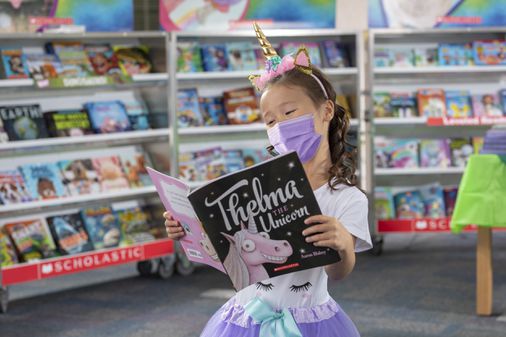
Many adults have fond memories of going to the school book fair as children, entering the school library clutching an order form and a few crumpled bills and leaving with a few shiny new books. For a lot of kids, it’s the first independent purchase they ever make.
But with recent controversies around the offerings provided by book fair giant Scholastic, concerns about equity when some families can’t afford the purchases, and new competitors launching their own alternative fairs, some teachers and librarians are asking whether we need book fairs at all.
Megan Murphy, who teaches education at Salem State and directs the Massachusetts Children’s Book Award program, says she has complicated feelings about book fairs, especially Scholastic.
“I was a classroom teacher in the Chicago public schools,” she says. “I didn’t have the money to build a really robust library without Scholastic. I think it can be a resource for teachers to get relatively affordable books for their classroom libraries.”
On the other hand, she notes, “when I was teaching in a lower income district, it did put a big financial strain on families who felt like they had to provide the money and didn’t always have it. And the messaging is then, well books aren’t for you — and that’s heartbreaking.”
When it comes to Scholastic, the undisputed giant of school book fairs, missteps around whether they’ll provide the full range of books in districts that have imposed restrictions on titles that conservatives consider inappropriate (typically any that mention race or feature LGBTQ characters) have alarmed observers.
“One of the best ways to learn empathy and perspective is just being exposed to other people and other ways of being,” Murphy says. “If you’re in a homogenous community, which so many people are, one of the ways we can gain perspective and understanding is through literature.”
Cambridge author Susan Tan is a Scholastic author (in addition to running school book fairs, the company is also a major publisher of children’s literature) who was stunned to learn that her own books had been relegated to the separate section, called Share Every Story, Celebrate Every Voice, which Scholastic allowed some districts to opt out of. (The company has since reversed the stance, although it remains unclear how they will provide a full range of titles in districts and states that have imposed such limits.)
“It’s really disheartening,” Tan says. “When I was a kid there were very few books that I had access to with Asian American characters. I would cling to them. It’s been so meaningful to me as an adult to create those stories.”
In Massachusetts, most book fairs are brought to schools by organizations led by parents as a way to raise additional funds for their schools. In the Scholastic model, which predominates (the company says it sells 100 million books to 35 million children each year), this consists of a physical sale that can include books, stickers, pencils, and other products.
Love My Library is just one of the many alternatives aiming to disrupt Scholastic’s dominance. A fully virtual sale platform launched earlier this year by the same organization that runs Read-A-Thon fund-raisers, Love My Library provides a lower-cost alternative for schools that may not be able to afford the Scholastic minimums, says CEO Toby Cunningham.
“A lot of Title One schools can’t do it, a lot of rural schools can’t do it,” he says. “Our passion is creating avid readers and nurturing a love of books while helping schools raise money.”
For Murphy and others, though, the question remains whether book fairs are really the right way to encourage reading, or to support public education, which is, after all, supposed to be funded by tax dollars.
“If we’re really focusing on access there are ways to do that that are much more equitable, like engaging with your local public library,” says Murphy.
